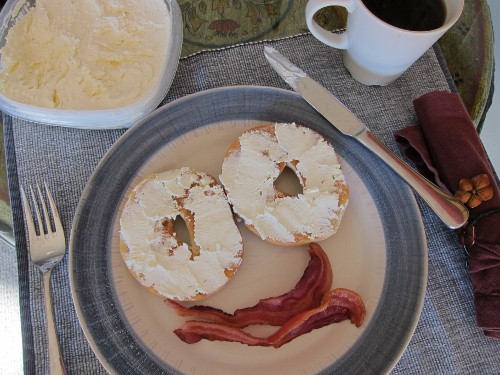
Edible Books, our new twitter-based book club, has been reading Make the Bread, Buy the Butter, by Jennifer Reese.
As soon as I read the section on homemade cream cheese, I was hooked. I skimmed the recipe and found nothing that seemed beyond my rudimentary cheese making abilities. The book promised that the cream cheese would be less than half the cost of Philadelphia cream cheese. It promised tangy. I daydreamed of Saturday morning bagels spread thickly with luscious cream cheese. I threw a cheering crowd into the picture for good measure.
I made my shopping list: liquid rennet, mesophilic culture, half-and-half.
I had to wait until Friday to make a trip to the home brew store, my local source for cheese-making supplies, to pick up the rennet and culture. The homebrew store is a warren of delightful tubes, bottles, packets, and other mysterious stuff. I quickly found my supplies in the refrigerator case.
The supplies rung up at $14.90. It’s not like you can just buy three drops of rennet, after all. Not until this moment had I really considered the front-end costs of this project, the fact that I actually rarely eat cream cheese and thus will be unlikely to recoup the cost of said supplies any time soon, nor the slight problem that I was soon going to have at least a pound of perishable cream cheese on my hands.
I quickly dismissed the $15.00 from my mind. I’d make something eventually with the rest of the supplies. Maybe everyone will be getting cream cheese for Christmas! In fact, maybe a few select friends will be getting cream cheese this weekend.
At the grocery store, I put two quarts of organic half-and-half in my cart. $4.39 each. I glanced across the aisle at the 8-oz boxes of Philadelphia Cream Cheese: $2.79. Organic Valley Cream Cheese: $3.45. Hmm.
Back home, I gathered my copy of Home Cheese Making by Ricki Carroll, lined a colander with cheese cloth, laid out my supplies, and placed a stockpot on the stove. Then I read through the recipe, stopping at “let sit at room temperature for 12 hours”. I glanced at the clock: It was 1:56 pm. We would not be having bagels and cream cheese for breakfast. I put the half-and-half in the refrigerator.
Later that evening, around 9:00 pm: I heated my cream to a precise 86 degrees, stirred in the starter and rennet, covered the pot, and set it aside.
Saturday morning, 10:00 am: I lifted the lid. The cream had set into one solid curd, and smelled delicious and fresh—rather like cream cheese in fact. I scooped the curd into a cheesecloth lined colander and let it drip during breakfast. Then I tied the cheesecloth into a bag, suspended it over the pot, and left it for the day.

Saturday evening, 9:00 pm: The cheese had stopped dripping whey, and was reduced in volume. I untied the bag, and turned the cream cheese into a bowl.
The cheese was light and creamy. I spread some on a cracker. It tasted fresh, a little tangy, and much, much better than store bought cream cheese.
Sunday morning: we spread cream cheese lavishly on our bagels and enjoyed every bite.

Here’s the breakdown:
Liquid Rennet: $7.95
Mesophilic Culture: $6.95
2 quarts Organic Half & Half: $8.78
Total: $23.68
1-8 oz package of Organic Valley Cream Cheese: $3.45.
It took very little active time to make the cream cheese, but the considerable waiting time pretty much mandates that this be a weekend activity. And it’s hardly cost effective.
But an objective analysis misses all the intangible reasons that it is still worthwhile to make your own cream cheese, at least once. There is the fun of a trip to a specialty store. The silkiness and the scent of warm cream as you stir it. The magic of cream becoming curd while you sleep. The plink, plink of whey dripping throughout the day, like a metronome or a heartbeat. The single-focus zen approach that cheese making requires—multitask at your peril.
And perhaps most importantly, which kind of person do you want to be? The kind who always analyzes before deciding? Or the kind of person who tries new things with enthusiasm and a willingness to enjoy the process, succeed or fail?
I’d rather be the person who makes the cream cheese.
Cream Cheese
(adapted from Home Cheese Making and Make the Bread, Buy the Butter)
- 2 quarts pasteurized half-and-half
- 1 packet direct set mesophilic starter
- 3 drops liquid rennet, diluted in 1/3 cup unchlorinated water
- 1 tsp kosher salt
Heat the cream to 86F. Add the starter and mix thoroughly. Add 1 tsp of the diluted rennet and stir gently with an up-and-down motion. Cover the pot and let sit at room temperature for about 12 hours. A solid curd will form.
Pour the curd into a colander lined with cheesecloth. Tie the corners of the cheesecloth into a knot and hang the bag to drain for up to 12 hours, or until the cheese is thickened and no longer dripping.
Stir in salt. Scoop into a container and store, tightly covered, in the refrigerator. Use within 1-2 weeks.
Yield: about 1 pound.











